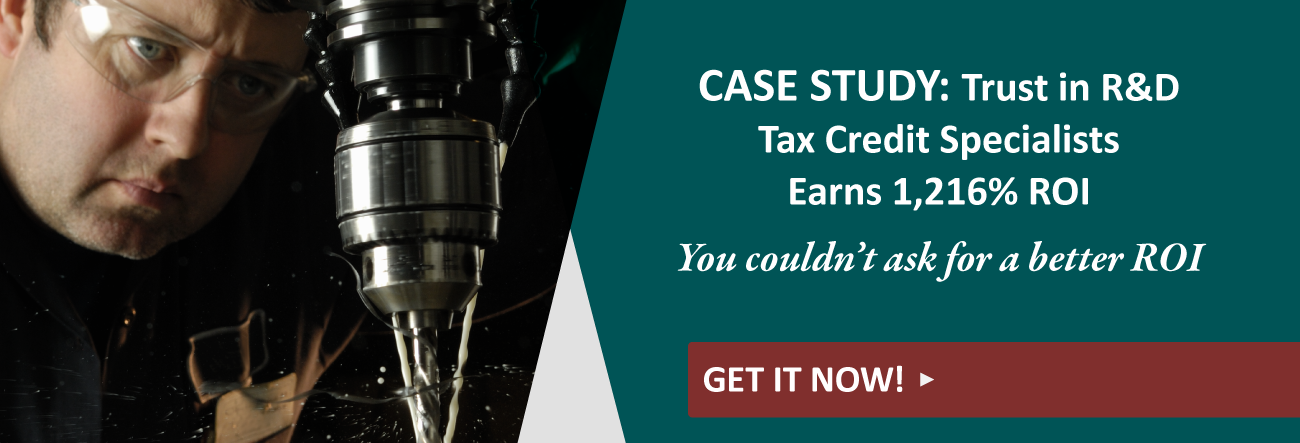 Many manufacturers are surprised to hear how many daily activities qualify for the R&D Tax Credit. In the eyes of the IRS, “research and development” includes common activities for manufacturers such as improving an existing product (e.g., improved material) or developing a new process (e.g., tooling).
Many manufacturers are surprised to hear how many daily activities qualify for the R&D Tax Credit. In the eyes of the IRS, “research and development” includes common activities for manufacturers such as improving an existing product (e.g., improved material) or developing a new process (e.g., tooling).
Once a business decides not to leave significant amounts of money on the table in the form of excess tax liability and instead explore R&D Tax Credits, it comes down to identifying qualified research expenses (QREs) during an R&D Tax Credit study.
Claiming the R&D Tax Credit requires completing IRS Form 6765 - Credit for Increasing Research Activities, which is the final step after thoroughly understanding 805 pages of tax code regarding research and development.
Below, we’ll explore IRS Form 6765 in detail so you understand exactly what’s expected. As you’ll see, the form is not particularly complex, but getting the right information to correctly complete the form is — and that’s why most companies partner with a qualified and experienced R&D Tax Credit expert. The right partner will know your industry, learn your business, work with you to complete a study, and stand behind the work performed in the event of an audit.
Are you receiving full value from the R&D Tax Credit?
Understanding Form 6765
At first glance, the form appears familiar and simple enough to fill out. However, the instructions are specific and require specific technical tax and industry knowledge to understand the 805 pages of tax code that apply.
Specifically, Internal Revenue Code (IRC) Section 41, which governs the research credit, is complex and minutely detailed. The definition of terms, qualifications, and caveats could confuse most anyone who isn’t an experienced R&D Tax Credit expert.
Plus, references to subsections of Section 41 appear throughout the instructions, which could further complicate one’s ability to process the information.
Details Required
In order to complete IRS Form 6765, you need to know and provide specific and qualified details such as the following:
- Is your company an eligible small business, a qualified small business, or a member of a controlled group of corporations? The type of business dictates the information you need to provide.
- How will you determine the base period for the research credit? Are you a well-established company or a start-up with less than 3 years of operation?
- Which of your activities are QREs and which aren’t?
- Does your qualified project list meet the IRS’ Four-Part Test? Activities must meet each of these elements:
- Permitted Purpose. The activity intended to make or improve either a product or process that results in improved function, performance, reliability, quality, or cost efficiency.
- Technical Uncertainty. The activity intended to eliminate technical uncertainty when developing or improving a product or process related to methodology, design, techniques, formulas, or inventions.
- Process of Experimentation. The activity that includes a process of experimentation to eliminate or resolve technical uncertainty. During the process, various alternatives and approaches are evaluated by modeling, simulation, trial and error, prototyping, and other methods.
- Technological in Nature. The process of experimentation must rely on the hard sciences (engineering, physics, biology, chemistry, computer science).
- As part of your documentation process, have you included interviews with appropriate subject matter experts (SMEs) to describe the qualified activities?
- Have you captured all of the qualified wages within the 9 steps of the manufacturing lifecycle that are specific to your industry?
- Have you captured all of your qualified supply expenses and qualified contractor expenses?
A Better Approach
Gathering all of the details that answer the questions above may seem overwhelming right now. Even seasoned CFOs and their CPA firm can be legitimately confused by all of the ins and outs of research and development.
Another approach to conducting an R&D Tax Credit study and then completing IRS Form 6765 is to work with a professional R&D tax specialist that knows the specifics of the law and your industry. A seasoned R&D pro can quickly and properly identify which of your company’s activities are eligible for the credit, determine the documentation necessary to support the claim, and help you receive the most credit for your research activities.
An R&D tax specialist, such as Black Line Group, helps you collect and organize all the documents you need to support your claim amounts. This is the smartest and most effective way to ensure that you have the most complete and correct information with which to complete IRS Form 6765 and properly file for the research credit.
Best of all, a key benefit of working with an R&D tax specialist is that this firm will stand behind the work performed in the event of an audit.
Not every manufacturer’s CFO or CPA understands research and development. Read a case study about how one business went against its CPA’s advice, claimed R&D Tax Credits, and enjoyed an ROI of 1,216% of the fee paid. Get your copy by clicking below now.





